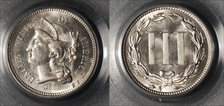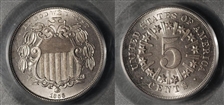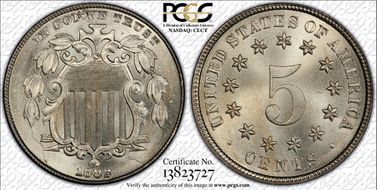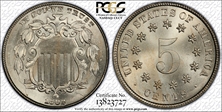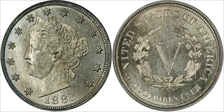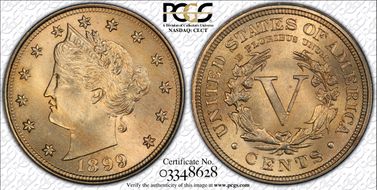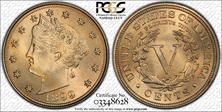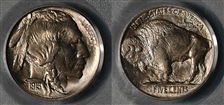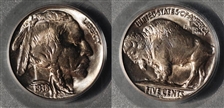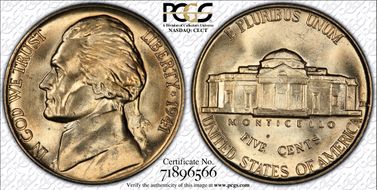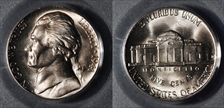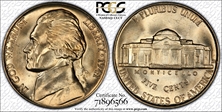Golbrecht's Raisinet Collection 的钱币相册
1868 3CN MS66. Well struck and untoned, with lustrous pearl-gray surfaces that are essentially unmarked on both sides. A splendid Premium Gem example of this conditionally scarce issue. Population: 25 in 66, 1 finer (2/07).(
1866 5C Rays MS65. A brilliant and lustrous Gem with a splendid strike and impressive preservation. The upper obverse has a forest of faint die cracks, as struck, while the reverse has wispy die cracks throughout the peripheral legends.
1882 5C MS66. Blazing luster is the hallmark of this exceptional, untoned Premium Gem. Spindly die cracks are noticeable on the obverse, as usual. A planchet flaw is observed on the upper obverse border, between D and W. Surface blemishes are nearly nonexistent. Population: 68 in 66, 4 finer (7/07).
1882 5C MS66. Blazing luster is the hallmark of this exceptional, untoned Premium Gem. Spindly die cracks are noticeable on the obverse, as usual. A planchet flaw is observed on the upper obverse border, between D and W. Surface blemishes are nearly nonexistent. Population: 68 in 66, 4 finer (7/07).
1883 No Cents MS66. Undoubtedly one of the most common type coins in all of U. S. numismatics, the 1883 No Cents nickel is easily located in all uncirculated grades, up to and including MS66. While it may be accurate to call the No Cents nickel a "common" coin, it is not often available and considering its status as a one-year type, it certainly is not overpriced in grades above MS65.
Blazing luster and light golden toning grace this unblemished Premium Gem. Well struck save for the usual blending on the left ear of corn.
Blazing luster and light golden toning grace this unblemished Premium Gem. Well struck save for the usual blending on the left ear of corn.
1913 5C Type 1, MS67. The 1913 Type One Buffalo nickel is always in great demand as a first-year-of-issue date and a one-year type coin. David Lange (2000) writes that: "The changeover to the Type 2 reverse was ordered on May 6, [1913] and coinage of the revised nickels commenced four days later." The present coin is a high-end example of this popular one-year type, strongly lustrous beneath pleasing gold and iridescent toning. Sharply struck and showing the rugged detail that makes the variety so prized, even LIBERTY and the obverse rim portray relatively nice detail, these features usually showing weakness on this issue. Each side has a pronounced matte-like texture, typical of all Type One nickels (David Lange, The Complete Guide to Buffalo Nickels). Noted sculptor James E. Fraser designed the Buffalo nickel. The first type, issued only in 1913, featured a textured field and a raised mound beneath the bison. Since the mound allowed the denomination to wear, it was recessed for the Type Two design, issued later in 1913. But the Mint neglected to recess the Indian's shoulder, where the date is, and well-circulated examples of either type are often dateless. This piece displays powder blue and light gold toning over vibrant luster, which combines with the finely granular surfaces to give each side a shimmering quality. The fields of all Type One Buffalo nickels, not just the proof coins, show the textured fields as on James Earle Fraser's original models, and therefore they give the coins' luster a "shimmering quality, particularly on unworn dies," according to Lange. In fact, "first strikes from unworn dies are easily mistaken for proofs and vice versa."
1938-D 5C Type 2, MS67. David Lange (2000) writes that: "The changeover to the Type 2 reverse was ordered on May 6 [1913], and coinage of the revised nickels commenced four days later." A nearly flawless specimen, this splendid example from the last year of Buffalo nickel production has virtually no flaws or detractions visible to the naked eye. The strike is bold and sharp as is normally seen on this final year issue. Mostly brilliant with a silver-gray finish and magnificent champagne and rose toning, both sides offer vibrant luster and strong detail.
1943-D 5C MS67 Full Steps. Mintage: 15,294,000. The 1943-D has the lowest mintage of any of the wartime alloy issues, yet it is one of the more commonly encountered wartime silver nickels. Boldly defined, this brilliant War nickel features a thin layer of champagne patina over lustrous surfaces. Fully detailed in all areas, as is usually seen on these wartime silver issues, the essentially perfect steps of Monticello are magnificently struck. The shimmering silvery surfaces have a light, golden patina on each side and are awash in bright, swirling mint luster. Pinpoint striking definition enhances the already stellar eye appeal. Possessing superb mint luster with just the faintest hint of light toning visible, this nearly flawless Superb Gem was obviously well cared for and expertly preserved since the day of issue.
1943-D 5C MS67 Full Steps. Mintage: 15,294,000. The 1943-D has the lowest mintage of any of the wartime alloy issues, yet it is one of the more commonly encountered wartime silver nickels. Boldly defined, this brilliant War nickel features a thin layer of champagne patina over lustrous surfaces. Fully detailed in all areas, as is usually seen on these wartime silver issues, the essentially perfect steps of Monticello are magnificently struck. The shimmering silvery surfaces have a light, golden patina on each side and are awash in bright, swirling mint luster. Pinpoint striking definition enhances the already stellar eye appeal. Possessing superb mint luster with just the faintest hint of light toning visible, this nearly flawless Superb Gem was obviously well cared for and expertly preserved since the day of issue.




















